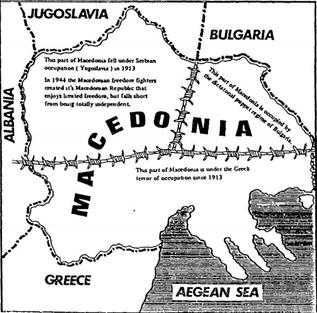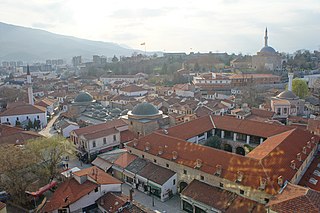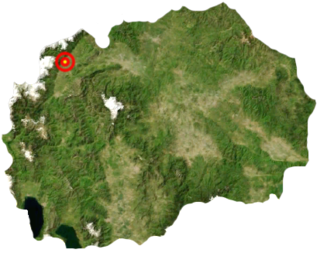
The National Liberation Army, also known as the Macedonian UÇK was an ethnic Albanian militant and separatist militia that operated in the Republic of Macedonia in 2001 and was closely associated with the Kosovo Liberation Army (KLA). Following the 2001 insurgency in Macedonia, it was disarmed through the Ohrid Framework Agreement, which gave greater rights and autonomy to the state's Macedonian Albanians.

The White Tower of Thessaloniki is a monument and museum on the waterfront of the city of Thessaloniki, capital of the region of Macedonia in northern Greece. The present tower replaced an old Byzantine fortification, known to have been mentioned around the 12th century, that the Ottoman Empire reconstructed to fortify the city's fortress some time after Sultan Murad II captured Thessaloniki in 1430. During the period of Ottoman rule, the tower became a notorious prison and the scene of numerous mass executions, most famously of the Janissaries who revolted during the reign of Mahmud II.
The Albanians in North Macedonia are the second largest ethnic group in North Macedonia, forming 446,245 individuals or 24.3% of the resident population. Of the 2,097,319 total population in the 2021 census, 619,187 or 29.52% are Albanians.

United Macedonia, or Greater Macedonia, is an irredentist concept among Macedonian nationalists that aims to unify the transnational region of Macedonia in Southeastern Europe into a single state that would be dominated by ethnic Macedonians. The proposed capital of such a United Macedonia is the city of Thessaloniki, the capital of Greek Macedonia, which ethnic Macedonians and the Yugoslav leader Josip Broz Tito had planned to incorporate into their own states.

The 2001 insurgency in Macedonia was an armed conflict which began when the ethnic Albanian National Liberation Army (NLA) insurgent group, formed from veterans of the Kosovo War and Insurgency in the Preševo Valley, attacked Macedonian security forces at the beginning of February 2001, and ended with the Ohrid Agreement, signed on 13 August of that same year. There were also claims that the NLA ultimately wished to see Albanian-majority areas secede from the country, though high-ranking members of the group have denied this. The conflict lasted throughout most of the year, although overall casualties remained limited to several dozen individuals on either side, according to sources from both sides of the conflict. With it, the Yugoslav Wars had reached Macedonia. The Socialist Republic of Macedonia had achieved peaceful independence from Yugoslavia in 1991.

Macedonian nationalism is a general grouping of nationalist ideas and concepts among ethnic Macedonians that were first formed in the late 19th century among separatists seeking the autonomy of the region of Macedonia from the Ottoman Empire. The idea evolved during the early 20th century alongside the first expressions of ethnic nationalism among the Slavs of Macedonia. The separate Macedonian nation gained recognition during World War II when the Socialist Republic of Macedonia was created as part of Yugoslavia. Macedonian historiography has since established links between the ethnic Macedonians and various historical events and individual figures that occurred in and originated from Macedonia, which range from the Middle Ages up to the 20th century. Following the independence of the Republic of Macedonia in the late 20th century, issues of Macedonian national identity have become contested by the country's neighbours, as some adherents to aggressive Macedonian nationalism, called Macedonism, hold more extreme beliefs such as an unbroken continuity between ancient Macedonians, and modern ethnic Macedonians, and views connected to the irredentist concept of a United Macedonia, which involves territorial claims on a large portion of Greece and Bulgaria, along with smaller regions of Albania, Kosovo and Serbia.

Čair is one of the ten municipalities that make up Skopje, the capital of North Macedonia. The municipal administration consists of a council and mayor. Skopje's old town is located in Čair. The municipality has a predominantly Albanian population.

The Skopje Fortress, commonly referred to as Kale, is a historic fortress located in the old town of Skopje, the capital of North Macedonia. It is located in Centar municipality and situated on the highest point in the city overlooking the Vardar River. The fortress is depicted on the coat of arms of Skopje, which in turn is incorporated in the city's flag.

Ilirida or the Republic of Ilirida is a proposed state in the western regions of North Macedonia, declared twice by the politician Nevzat Halili, once in 1992 and again in 2014. The proposal has been declared unconstitutional by the Macedonian government. The secessionist concept of Ilirida emerged in the early 1990s and was advocated by some Albanian politicians as a solution to concerns and disputes the Albanian community had regarding constitutional recognition and minority rights within Macedonia.

The Battle of Tetovo, was the largest engagement during the 2001 insurgency in the Republic of Macedonia, in which Macedonian security forces battled Albanian insurgents of the National Liberation Army for control of the city.

The Old Bazaar also known as Turkish Bazaar is a bazaar located in Skopje, North Macedonia, situated on the eastern bank of the Vardar River, stretching from the Stone Bridge to the Bit-Pazar and from the Skopje Fortress to the Serava river. The Old Bazaar falls primarily within the borders of Čair Municipality but a part of it is located in Centar Municipality. As one of the oldest and largest marketplaces in the Balkans, it has been Skopje's centre for trade and commerce since at least the 12th century.

The Kingdom of Serbia was one of the major parties in the Balkan Wars, gaining land in both conflicts. It experienced significant territorial gains in the Central Balkans, nearly doubling its territory.

Operation Mountain Storm was a military operation carried out on 7 November 2007 by special police forces of the Republic of Macedonia against an armed ethnic Albanian group in the Šar Mountains of Brodec above Tetovo region with ties to Albanian paramilitary of the conflicts in Kosovo (1998–1999), Preševo Valley (2000–2001) and Macedonia (2001). The operation was carried out to remove and destroy the Albanian terrorist-extremist criminal groups that came from Kosovo, which threatened to disturb the peace and stability in the Republic of Macedonia.
The Vejce ambush or Vejce massacre was carried out by the National Liberation Army against a Special Operations Regiment convoy near the village of Vejce. During the attack, eight soldiers were killed, marking the highest death toll for government forces in a single incident during the 2001 insurgency in Macedonia.
Poum is a village in the municipality of Struga, North Macedonia.
Albanian nationalism in North Macedonia traces its roots in the wider Albanian nationalist movement which emerged as a response to the Eastern Crisis (1878) and proposed partitioning of Ottoman Albanian inhabited lands in the Balkans among neighbouring countries. During the remainder of the late Ottoman period various disagreements culminated between Albanian nationalists and the Ottoman Empire over socio-cultural rights. The Balkan Wars (1912–13) ending with Ottoman defeat, Serbian and later Yugoslav sovereignty over the area generated an Albanian nationalism that has become distinct to North Macedonia stressing Albanian language, culture and identity within the context of state and sociopolitical rights. Pan-Albanian sentiments are also present and historically have been achieved only once when western Macedonia was united by Italian Axis forces to their protectorate of Albania during the Second World War.
The Karpalak ambush, referred to by Macedonians as the Karpalak massacre, was an attack carried out by the National Liberation Army (NLA) against a convoy of the Army of the Republic of Macedonia (ARM) near the village of Grupčin on 8 August 2001 during the 2001 insurgency in Macedonia. Ten members of the ARM's Military Reserve Force, including two officers, were killed at Karpalak and three others were wounded. The ambush was the single deadliest incident of the conflict up until that point. It was speculated that the ambush was carried out in retaliation for a Macedonian police raid in Skopje, the day before in which five NLA insurgents were killed.
The Tanuševci operation was a joint Macedonian-KFOR operation to regain control of the village of Tanuševci which was previously infiltrated by NLA rebels. The operation was successful with NATO-led KFOR forces capturing the village and Macedonian Army units sweeping the area and ambushing the retreating NLA.
During the 2001 insurgency in Macedonia, a raid was conducted by the Macedonian police against ethnic Albanian rebels in a suburb of Skopje on 7 August. The police killed the rebel group and captured their weapon supplies.











